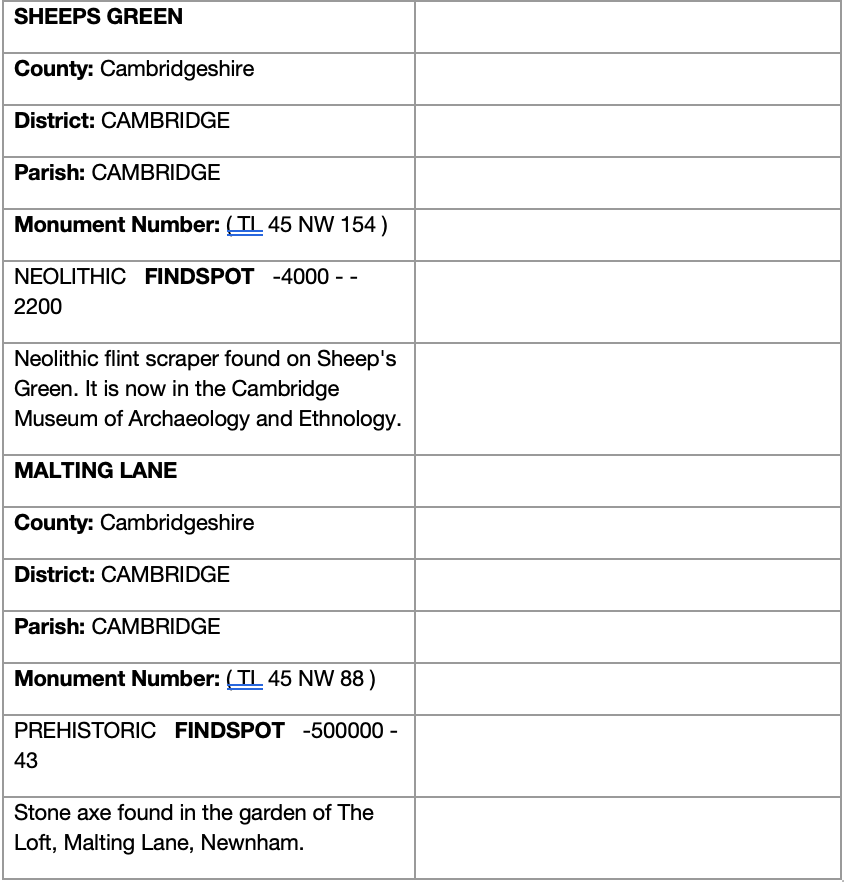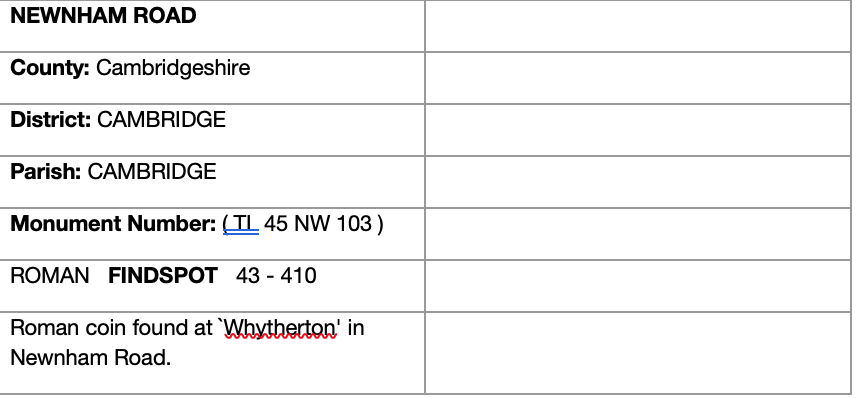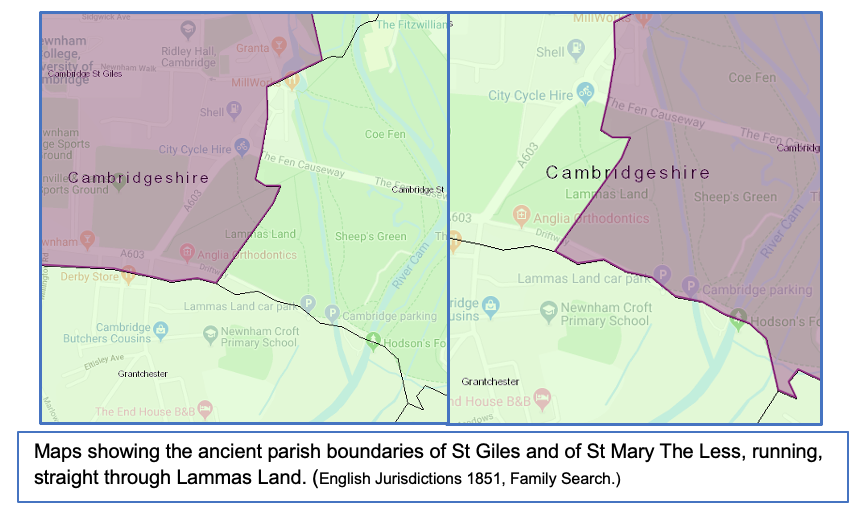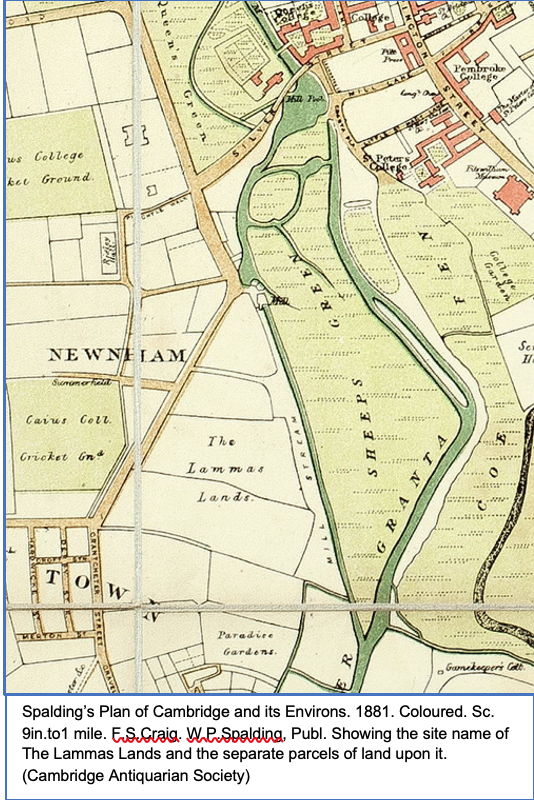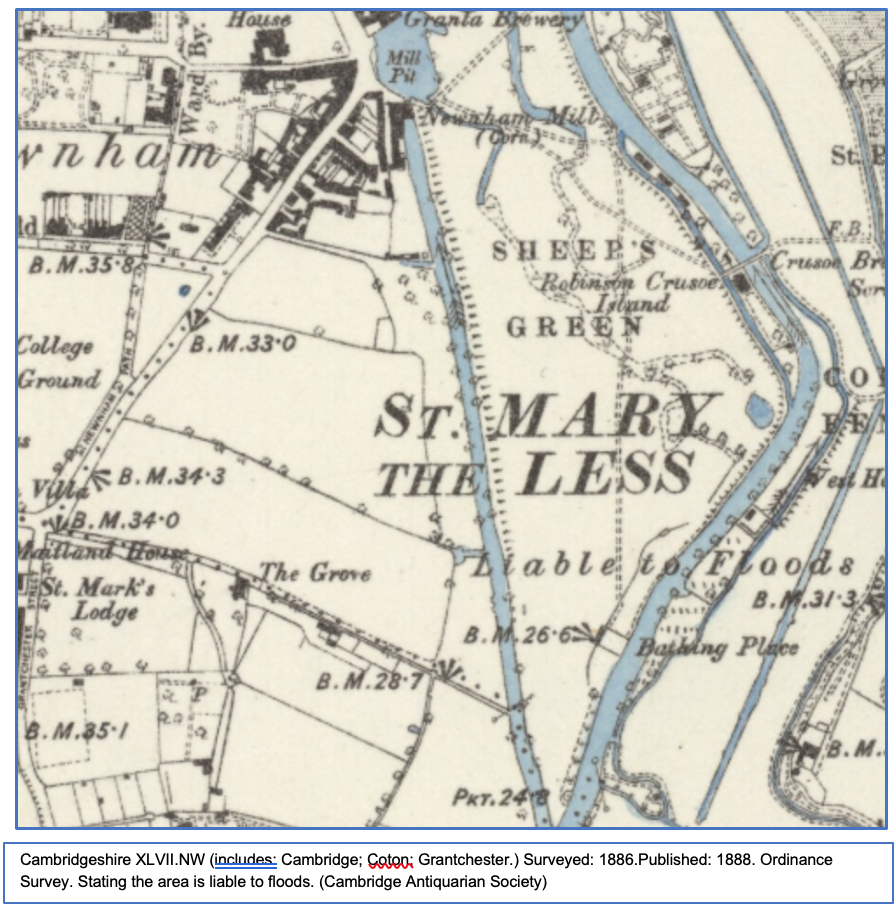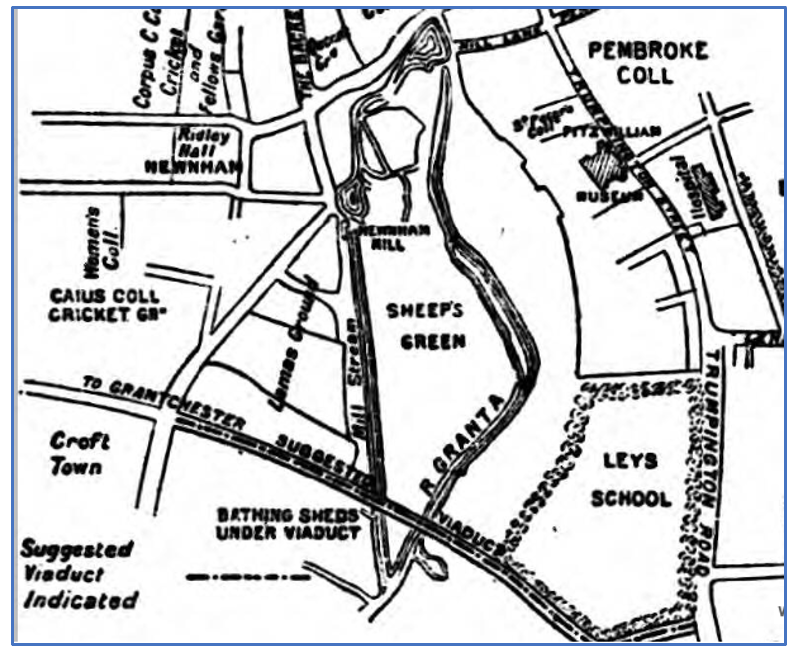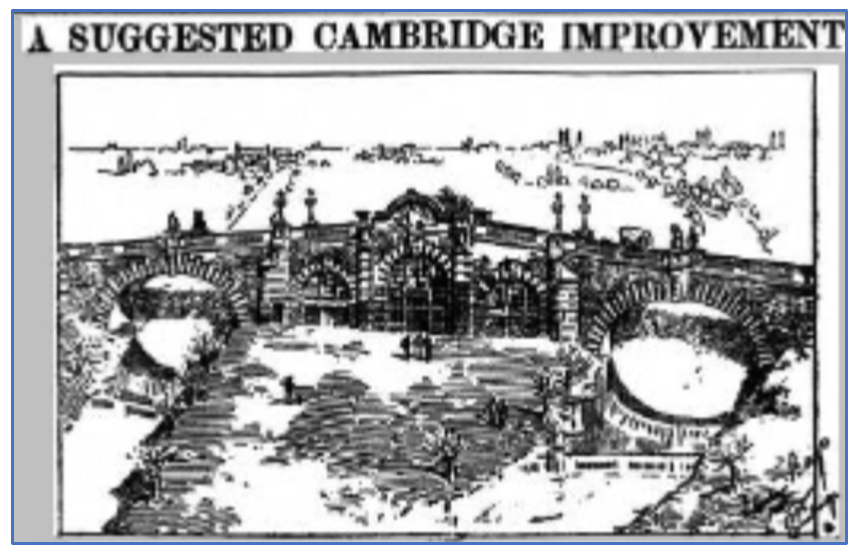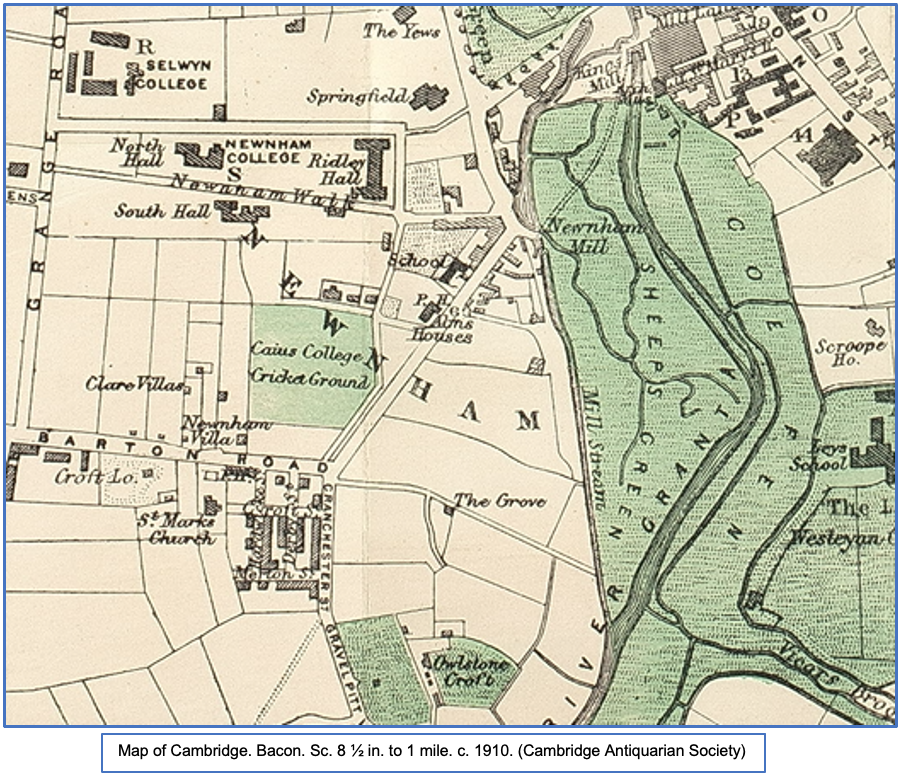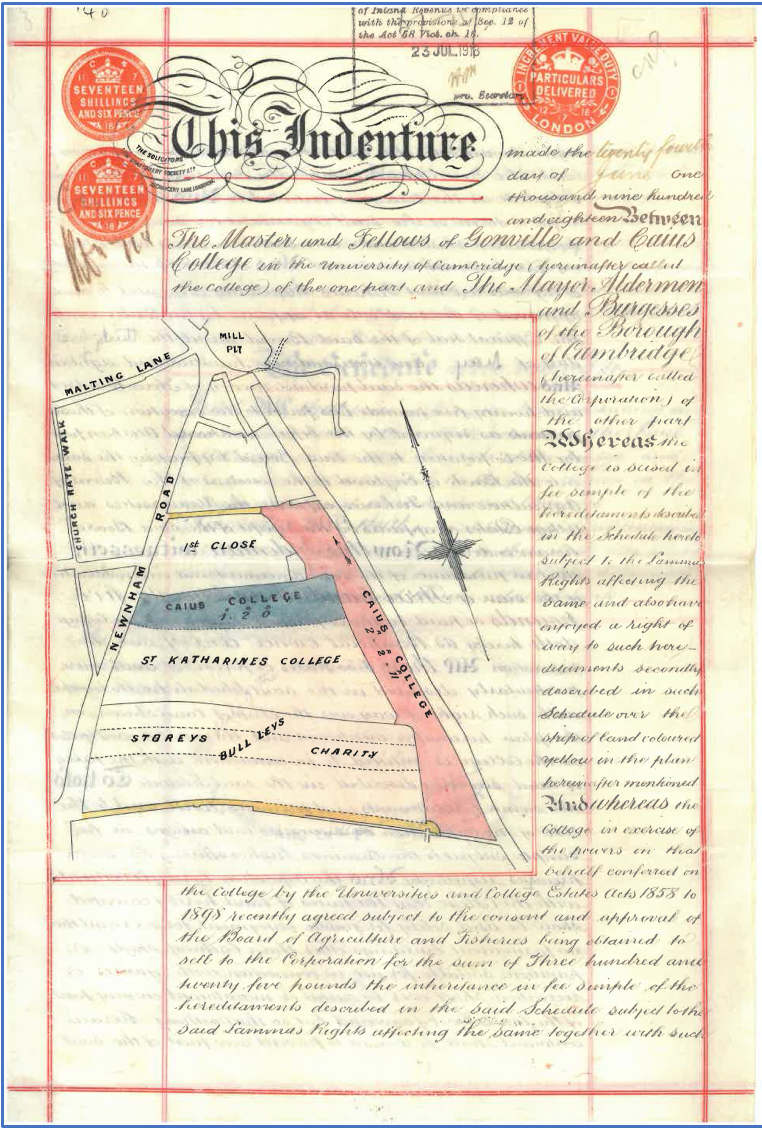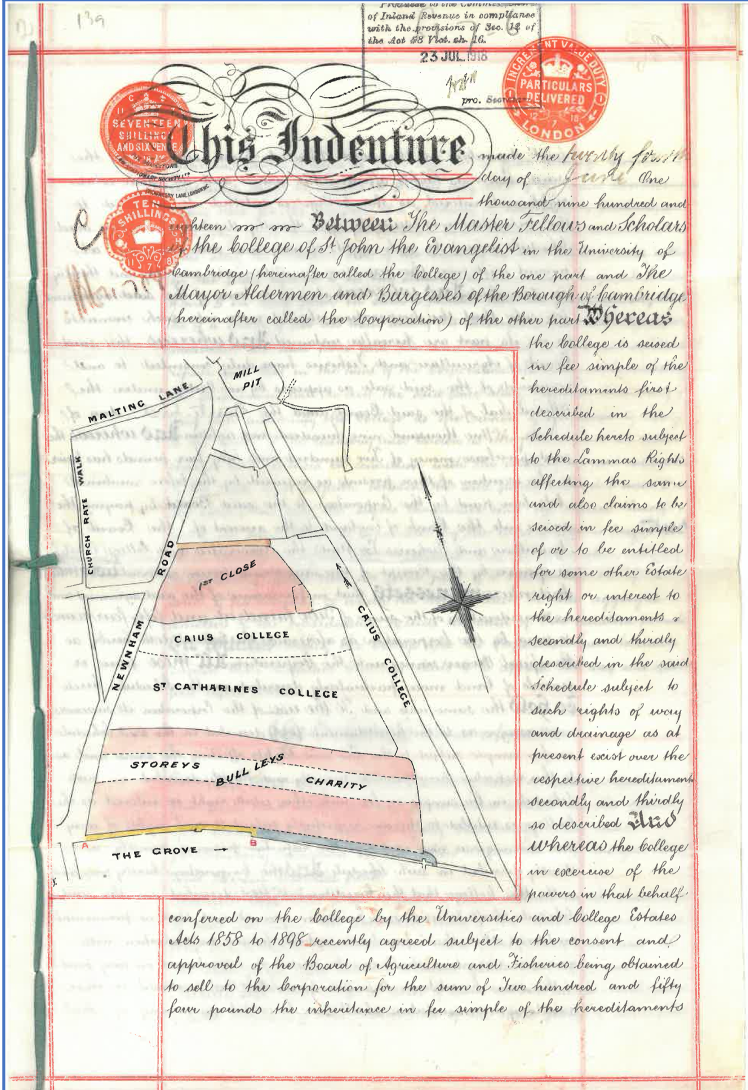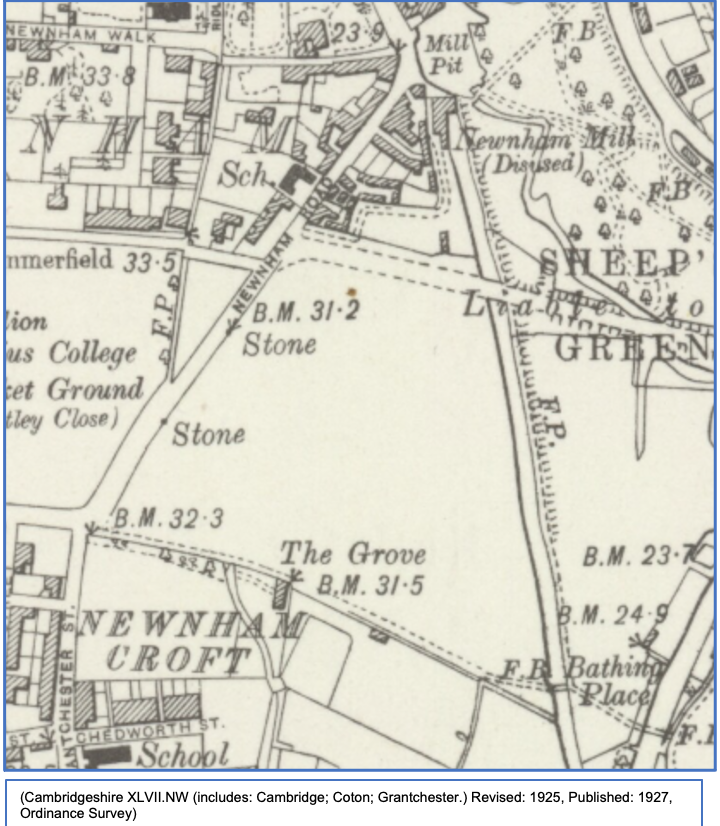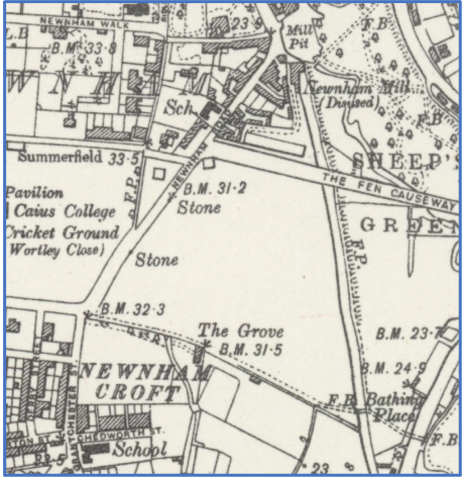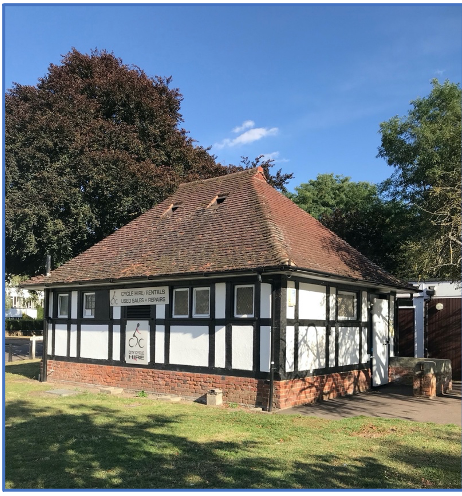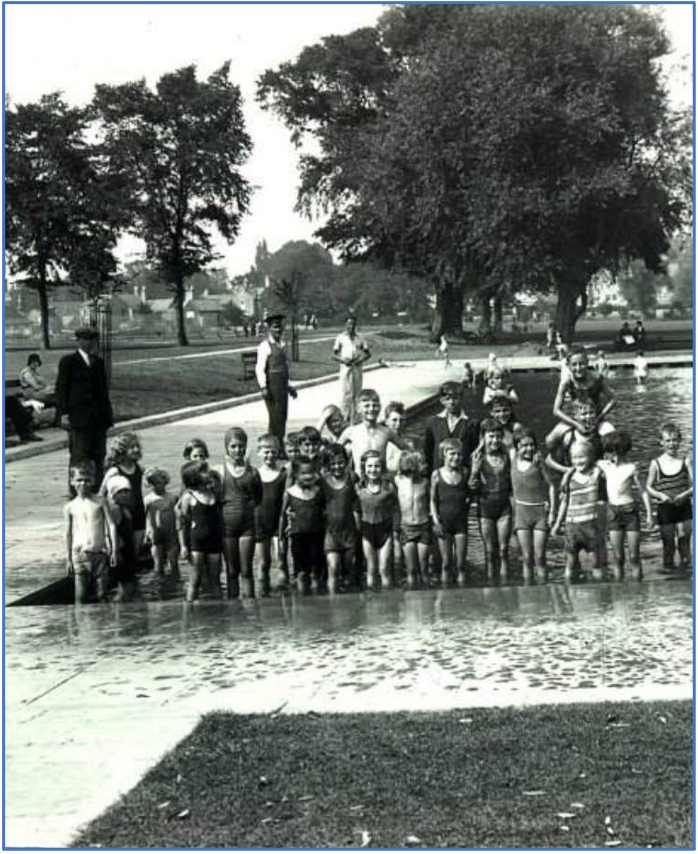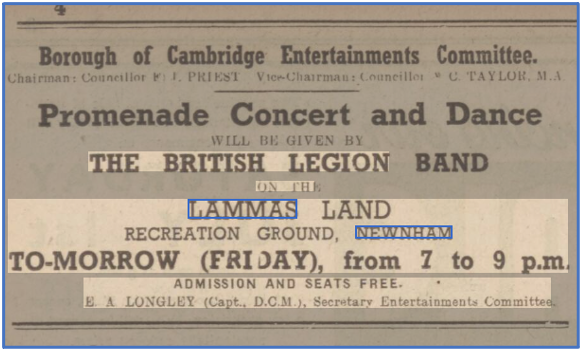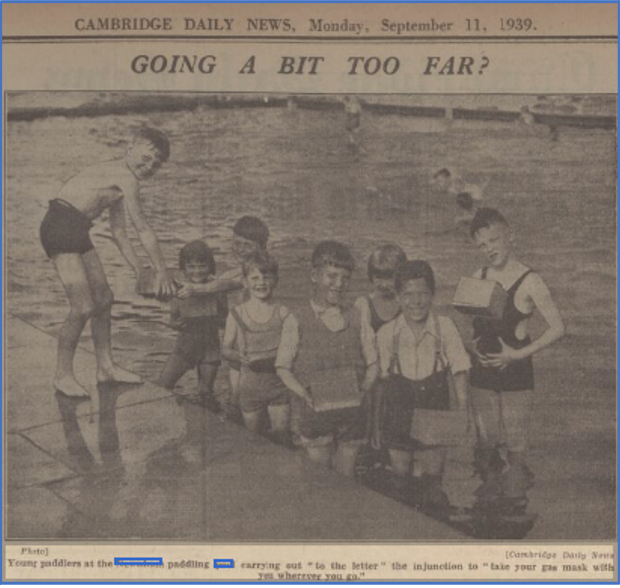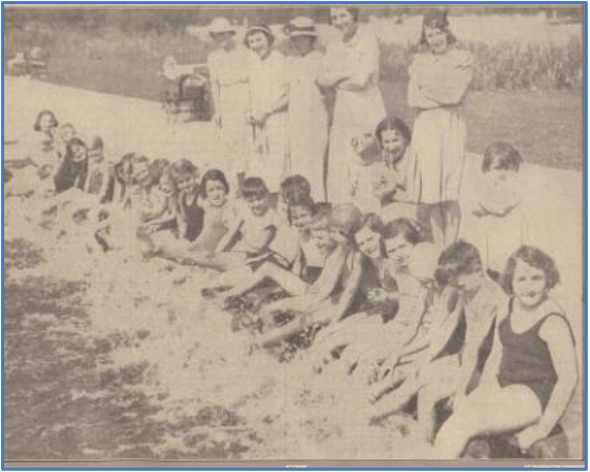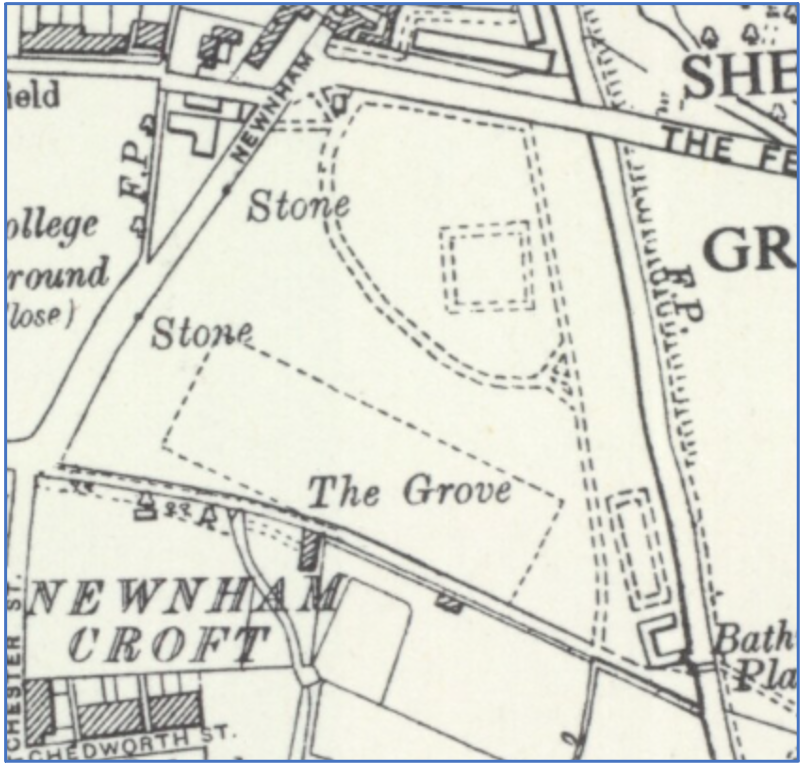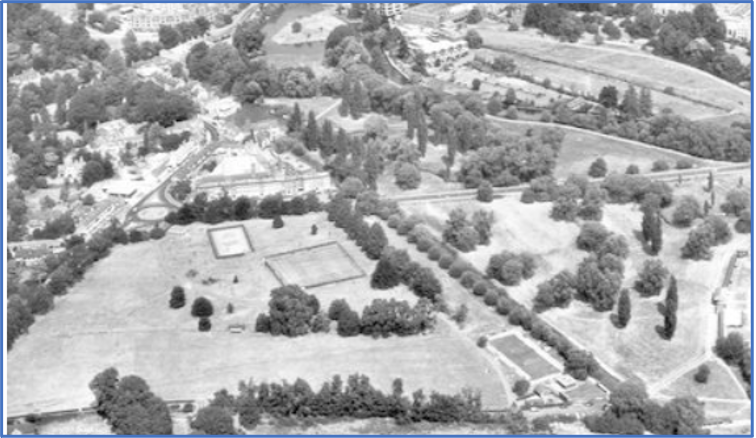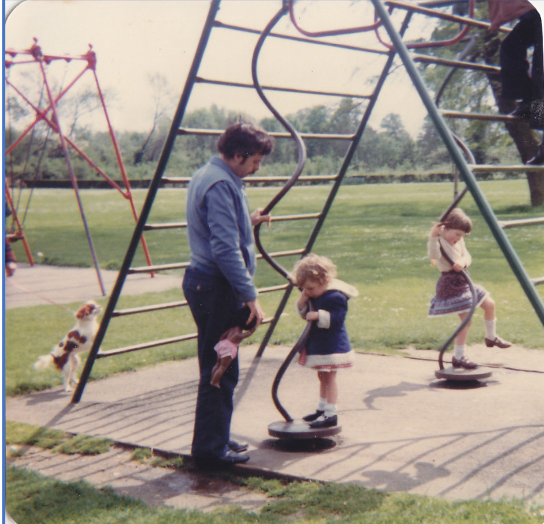|
Thought I'd share this history of Lammas Land which I compiled as part of the site Management Plan for Cambridge City Council, so it is in a rather 'report' style. I will expand on this in a separate book at some point but as always, I like to get the info that I have worked on, out there for you to enjoy and as 'Newnham' is such a popular place that so many of us have visited over the years, enjoying the paddling pool, river and park, I thought it may be of some interest :)
Lammas Land is a 5.45ha*, Cambridge City Council owned public park, within the ward of Newnham and about half a mile from Cambridge City centre. It consists of open green spaces, a variety and abundance of trees and shrubs, a shared waterway, an extensive playpark and a large paddling pool, tennis courts, bowling green and other leisure features. The site is situated within what was once a much larger area of historical common land and as such there are many ancient willows, which are still traditionally managed by pollarding. Other open green spaces, such as Sheep’s Green and Coe Fen, are easily accessed by the bridges connecting the sites and the Paradise Nature Reserve is accessed from the immediate south-east corner of the site, just beyond the Lammas Land car park. Lammas Land is bound by Snobs Stream on its eastern side, by The Driftway on the south, Newnham Road on the west and The Fen Causeway bounds its northern aspect.
* not including the car park
A1 - Archaeological finds recorded on the Historic Environment Register (HER) in the immediate vicinity of Lammas Land:
From early times Lammas Land, Sheep’s Green and Paradise were all part of a large stretch of marshy common land, they were bound by the River Cam on the east, with Coe Fen being on the northern side of The Cam. All within an area that was, in the past, relatively boggy and marshy, and prone to seasonal flooding due to the close proximity to the river. The challenging nature of this area meant that there was little settlement within the immediate area, until the area became better drained and more accessible in the more recent past, from the ninetieth century.
Grantchester Meadows stretched outwards on the south side of the site which, in its original form, runs as a routeway from where Lammas Land car park is now, continuing south west through the area now known as Paradise Woods. Further on became a metalled and named street, before continuing onwards, more or less parallel to the River Cam, on its route through Grantchester village. The south boundary, with its continuation along the immediate south edge of Lammas Land, in the form of the road known today as The Driftway, is a continuation of Barton Road (A603) which runs off to the south west and follows what was an ancient prehistoric routeway, where further along its length near Barton Village towards Wimpole, it was metalled during the Roman period for use as a Roman military road. What was to become Newnham Road ran alongside the west side of Lammas Land and The Fen Causeway wasn’t built until 1926, which gave the site a final and distinct boundary.
Newnham was a small hamlet within the Grantchester parish, there were also some scattered pockets of settlement around the area north of Lammas Land by the mill known as Newnham Mill which fell within the St. Giles Parish boundary. The mill was mentioned in the Domesday record in 1086. In 1256 a Carmelite religious order had settled in the area but even they found the water-logged conditions too much, as they were frequently cut off from Cambridge town by flooding, they had left the site by 1292, to move into the town of Cambridge. In Newnham Croft, as it was known during the medieval period, the ancient furlongs were divided into croft land by at least the 15th century. These crofts were owned or leased by men from both Cambridge and the surrounding parishes. A Cambridge butcher owned a share in the meadow in 1346, this is also likely linked to the place name of Butchers Croft which appears on some old topographical descriptions of the area, in and around Lammas Land, along with the surrounding common land. Limited housing development growth took place in the area due to the very marshy and boggy fen covering the fields between Cambridge and Grantchester.
Enclosure took place in the parishes around Lammas Land at the beginning of the 1800’s. Before enclosure, when the Open and Common Field systems were still in general use, Lammas Land, and the waste and common land surrounding it were shared by the surrounding parishes of Grantchester and Coton, St Giles, St Mary the Less and Trumpington. Lammas Land lay right in the corner of these parishes. With The Driftway marking the parish boundary of Grantchester and Coton, to the north east of The Driftway the River Cam marked the parish boundary of Trumpington, and the boundary between the parishes of St Giles and St Mary the Less ran straight through the site in a north east, south west line. Together these parishes exercised a mixed Right of Common in this area.
The name Lammas comes from the Lammas rights, which were Rights of Common that entitled commoners to pasture following the harvest, between Lammas day, 12 August to the 6 April, even if they did not have other rights to the land. These rights, sometimes having the effect of preventing enclosure and building development on agricultural land, helped to preserve the site from general development and save it as a green, open space. Rights of Common still apply to areas of the adjacent sites of Sheep’s Green and Coe Fen.
The River Cam today follows a different course than its original one. In earlier times The Cam would have followed a route through the commons along, what is now a stream called The Rush, which today runs through Sheep’s Green, in a north westerly direction to meet with the mill and mill pond. The name The Rush, gives clues to its industrial use for the ancient mill which stood to the north of Lammas Land. During the medieval period, a new, straight mill leete was cut, to lead from the River Cam in the south east to the mill in the north, where there was obviously a need for a better controlled use of the water. This leete, known as Snobs Stream today, bounds Lammas Land on the east and is abundant with wildlife and ecology. The River Cam, in this area, was itself diverted and straightened, probably around a similar time during the medieval period, in part at least, to assist the larger mill, known as the Bishop’s and Kings Mill, which was situated at the bottom of Mill Lane, Cambridge, at Granta Place, just to the east of the mill that stood north of Lammas Land. This demonstrates how close Lammas Land was to the original River Cam and these changes assisted with drainage at the Lammas Land site and created a more accessible area of common grazing.
On the 29th April 1868, the Cambridge Chronicle and Journal, describes an event regarding the continuing claims of Common Rights that were still taking place within the area that made up todays Sheep’s Green, Coe Fen and Lammas Land. It also shows that in 1868 the site was still not yet known by its sole name of Lammas Land but was instead often referred to as ‘the Lammas lands’. Part of it was called Bull Leys and known for the Common Right of Lammas and lay to the southern aspect of the site.
“Lammas Land – Malicious Injury. Quick John Lilley, of the Coach and Horses, Newnham, was summoned at the instance of Mr. Lambert, of the Half Moon Inn, Trumpington Street, and a tenant under Saint John’s College, as occupier of a portion of Bull Leys, Newnham, for breaking and injuring part of the fence enclosing Bull Leys. Mr French appeared for the complainant; and Mr Hunt for the defendant. Mr French: I understand that the defence will be that this malicious injury was committed as a matter of right. The defence, I understand, will admit to that. Mr Hunt: Yes, as a matter of right, but I raise the question of title. Mr French: Surely the defence set up will not be held valid by the Magistrates, for nothing can be easier in matters of this nature that for a defendant to raise the question of title for the mere purpose of oasting the jurisdiction of the Magistrates. I shall prove to you that Mr. Lambert has occupied this land for nearly twenty years, that he has paid rates for it, and during the whole of that time he has maintained and kept up this fence, now broken down by the defendant. The only defence that could be put up was that the ground was Lammas Land, and therefore the defendant might at this time of the year have right to feed on it, but certainly he had no right maliciously and unnecessarily to break the fence. There was no excuse for it, as there were several other places left purposely open for Ingress and egress of stock during Lammas – Mr Beales: It is a question in which the Magistrates have no jurisdiction. We are advices by our Clerk that the objection is valid. – Mr French: I am surprised to hear that, because, if that is so, persons having a right to stock Parker’s Piece, Christ’s Piece, Midsummer Common, and other places, would have an equal right to break down the railings enclosing those places, which surely cannot be. – Mr Beals: We decline to interfere. – Mr Hunt: You cannot enclose an inch. You must take down the fence. – Mr French: With a view to having a cheap and speedy law, I advised my client to apply to the Magistrates; it, however, appears Mr. Hunt’s client is not so disposed. – Mr Beals: We have no jurisdiction. – Mr French: Well we shall have to take the matter into a superior Court. – Mr Lambert: Yes, if it costs me £50.” (British Newspaper Archive)
On the map below the site of Lammas Land can be seen with its separated parcels of land and showing Snobs Stream running off of the River Cam straight down to the mill.
On the 25th March 1871, Cambridge Independent Press mentions Bull’s Leys which cover the length of the southern area of todays recreation ground on Lammas Land. The report gives clues to the ownership and use of the site at this time.
“The Paving and Drainage Committee, having also considered the memorial as to the nuisance arising from the manure heap on land in the occupation of the Commissioners at Newnham, and having had an offer from Mr. Moyes to let a larger piece of ground further from the public roadway for the purpose of storing manure, at a rental of £8 per annum (instead of £5 now), it was unanimously recommended that with a view of obviating the nuisance complained of, such offer be accepted, and a new lease prepared in accordance therewith. Dr Fawcett moved the adoption of the report. A discussion then ensued, during which in transpired that the ground in question was called Bull’s Leys, which was Lammas Land, and held on lease from St. Catherine’s College, and that Mr Moyes had not the power to make such an offer.” (British Newspaper Archive)
After Enclosure had taken place, Cambridge was divided into five Wards, then after the enlargement of 1911 the Borough was divided into ten wards with two more added in 1935, changing the original parish system. Newnham Ward was created in 1911, expanding upon the area known as Newnham Croft and separating it out as a distinct area, no longer held within a parish system. This gave the area a much more defined boundary and identity. There was a bloom in the development of the area, resulting in new housing and the need for recreational and leisure space. Newnham College was built to the north east in 1875, which attracted associated development and further distinction for Newnham, as a distinct area, in its own right.
Students and the public were, by at least the latter part of the 19th century, using the River Cam and Snobs Stream as bathing places and some formal swimming lessons were taking place there. An article in the Cambridge Independent Press, 12th November 1870 was already beginning discussions on providing more formalised recreation at the sites. Discussions were held at Town Council stating that every respect for vested rights would be shown, and no attack on gentlemen who had exclusive privileges in connection with the Common would be made. The plan was put forward to provide, on Sheep’s Green means of healthy recreation, by erecting proper bathing places, and that they might be made so as not to be unsightly. Due to the nature of these areas and open common, the sites were also used, when the weather allowed for ice skating. Space such as this, naturally began to lend themselves well to recreational activities.
In 1876 the Commons Act was passed, an article in the Cambridge Independent Press, 12th January 1878, describes concerns that were raised at the Town Council meeting and shows that the site was described as Newnham-paddocks rather than its present-day name:
“…The condition of the commons and open spaces within the borough for generations past has been most unsatisfactory, but it appears that the remedy is placed within our reach by the Commons Act of 1876, and it may be hoped that perfect unanimity will permit its application. The schedule accompanying the report specifies various commons, showing the total acreage to be about 300, but no mention is made of several plots of Lammas Land, such as Christ’s Pieces, New-square, and the Newnham-paddocks. With respect to these it may be presumed that there exist ancient rights, which are vested in certain colleges; but these can be of little more than nominal value, the interests of the public being paramount. Such as they are, however, they are a hinderance to improvement or to the proper maintenance of order, and the object of this letter is to suggest that these, with any other open spaces – should such exist – be included in the Corporation scheme to be referred to the Assistant Commissioner at the proposed inquiry.” (British Newspaper Archive)
Plans to build a viaduct, continuing from the end of The Driftway, going over Snobs Stream and then over the River Cam, were published in the Cambridge Chronicle and Journal on 3rd May 1895. The plans showed that the bathing sheds would be under the viaduct and would provide access from Newnham, towards Cambridge train station, via a more direct route. The plans presented the idea that:
“The continuation of the Tram Lines from Bateman Street to Grantchester and Barton would go far “to attract the people from the slums and alleys of our congested, unhealthy town into the green lanes and fair meadow lands of the country where the white violet blows and the daffodil dances in the breeze, and the winter aconite hangs its golden bell.” (British Newspaper Archive) This scheme never came to fruition, but it opened the discussions further on improvements needed and paved the way to further planning. Note Lammas Land is called Lammas Ground. Most importantly the plans referred to using part of the land to be converted to a recreation ground with the combined aid of the Corporation and the County Council. This was part of the first movement to address the need and desire for a designated public recreation ground in the area.
By the end of the 19th century, the question of suitable bathing areas was still a much-discussed topic. The River Cam and Snobs Stream in particular were still being frequently used as a bathing place. As this article, from the Cambridge Chronicle and Journal, 7th September 1894, demonstrates:
“…an increasing desire to have a swimming bath for ladies, I would suggest a site behind Newnham Mill, where Lammas ground commences. If the bed of the stream [Snobs Stream] could be cleared out about twenty or thirty yards, the bottom concreated, and sides lined with enamel bricks, or, if too expensive, ordinary tiles, with a depth of from three, graduating to five feet, open at each end, so that the water might freely flow through, a strong wooden shed could be erected similar to the one now on the green, well lighted from the roof, with a sliding panel for hot weather, and the building would be complete. The interior might be fitted up afterwards with dressing boxes. A good entrance can be made from the Newnham side, opposite the schools – and will take in conveniently those who, I believe, will be the greatest patrons, the lady students at Newnham…” (British Newspaper Archive) The challenges presented by the lack of suitable bathing sheds was also mentioned in this letter in the Cambridge Chronicle and Journal, 27th July 1894: “…I occupy a house directly opposite the Green and in full view of the bathers, and I have several females connected with my establishment, and the sight of nude men and boys running round the Green at all hours of the day, Sundays and week-days alike, is not a very moral spectacle for them. A great many people who cross the Green by the public path have expressed their opinion that the exhibition throughout the day is simply disgusting. I don’t think that in any civilized town in England that has bathing facilities would this be allowed. Bathing dress is an inexpensive item, and I think that all moral minded men would wish to see this disgrace to the town of Cambridge wiped out. I may add that a great many inhabitants of Newnham have expressed their opinion that the wearing of bathing dress while bathing (at least after 10 o’clock in the morning) is most desirable.” (British Newspaper Archive)
After 1900 there was further rapid development in the area, with sponsorship of the Cambridge colleges supporting this action. There were 160 new houses built including housing around Owlstone Road, Eltisley Avenue, Millington Avenue and Fulbroke Road, further defining Newnham as a distinct community. The commons and Lammas Lands, along with the college sports fields contained this new development to the south and east of the site, it is worth noting that today, Lammas Land along with associated green spaces continues to protect the area from in-filling development, which helps retain Newnham’s distinct character of a village like settlement.
On 9th August 1907, the Cambridge Independent Press, printed details of work to be carried out in the area, for widening Newnham Road presumably due to amount of new development going on. Note here we see the loss of a strip of the Lammas Land.
“Newnham Road – Continue the improvement on the south east side to the “Coach and Horses” involving the purchase of some houses, and beyond the “Coach and Horses” only, requiring a strip from the Lammas Land” (British Newspaper Archive) “Newham Road widening – Property on south-east side up to and including the “Coach and Horses” publichouse, and strip off Lammas Land” 27th September 1907, (British Newspaper Archive).
Spurred on by a letter received by the Council, from Rev. Symonds, of St. Mark’s Parsonage in Newnham, discussions to create a much needed and more formalised recreation ground, started to gain momentum by 1913 and several Town Council meetings were held regarding the matter. There was some little resistance to the proposals but overall the idea was approved, and the Council proceeded to acquire the land with the view of turning it into a recreation ground. On June 13th 1913, The Cambridge Independent Press published Town Council minutes, that provide great detail on the previous owners of the land within the site and the costs at which the Council would pay to gain the land.
“Newham Recreation Ground. The Commons and Paving, Drainage and Lighting (Joint) Committee reported that in April, 1912, a letter was received from the Rev. S. Symonds, of St. Mark’s Parsonage, suggesting that the Corporation should acquire or hire a portion of the Lammas Land, so that it might be free for children as a playground for the whole of the year. He pointed out that for eight or nine months in each year the Lammas land provided an excellent recreation ground for the young people in the neighbourhood, but from April to July the ground was closed just when it was most needed. The Commons Committee instructed the Town Clerk to communicate with the owners of the various Lammas lands as to the terms on which they would be disposed to convey their interests in the land to the Corporation, and in reply to his queries he received he received the following offers from the respective owners:- Gonville and Caius College – area, about 2a. 2r. 11p.; price £250 – the Corporation paying all costs, the land to be used solely for public enjoyment, and not for the purpose of building (except the erection of bathing sheds). St John’s College – area, 5a. 1r. 6p.; price, £254 – the land to be used for the purpose of recreation ground purchases paying all expenses of, and incidental to the transaction, subject to certain covenants, one of which would be the erection of an unclimbable iron fence along the driftway past The Grove; St Catherine’s College – area, 5a. 0r. 1p.; price £250 6s. 3d. The land belonging to Gonville and Caius College is next to the river, continues the report. And is not subject to Lammas rights, and would be an admirable site for additional bathing accommodation for women, which must be provided in the near future. The committee are of the opinion that for various reasons the whole of the land mentioned in the above schedule should be in the hands of the Council, and that the prices asked for are fair and reasonable. They therefore recommend that the land should be acquired on the above terms, and that the Town Clerk be instructed to apply to the Local Government Board for permission to borrow the necessary sum for the purchase of the land, including the payment of the costs. The committee too further recommend that in the meantime further provisional arrangements be entered into with the owners for the purchase of their interest…..It was quite clear that if the Council bought rights over this land, in respect of which they already owned some rights, they would have to go to Parliament in connection with the extinguishment of the common rights if the ground was to be turned into a recreation ground. The neighbourhood had at present no recreation ground at all. It was perfectly clear that the present system of Lammas rights was very unsatisfactory and wasteful. They had certain dominant rights. The land was under hay for the greater part of the year, and then in August or at the end of July the community went in as a right.” (Mike Petty, www.mikepetty.org.uk) “Cambridge Ratepayers. Inaugural meeting of the Association….”Highly-Paid Officials” Mr Daintry criticised the proposals to purchase the Lammas Land at Newnham for a recreation ground as an unnecessary proceeding. The rate-payers out to resist paying officials high salaries for soft jobs. Let them look at the officials in Cambridge, drawing hundreds a year. He called it legalised plunder. If they must pay these officials out of rates, let them pay what a private person would pay them, and not twenty times as much.” (Cambridge Independent Press, 20th June 1913, British Newspaper Archive)
Alongside the debate into the possibility of a recreation ground at Lammas Land, much was being discussed about the surrounding roadways and bridges over, and from the site. On the 20th March 1914, Cambridge Independent Press, published details into the discussion had, regarding this matter:
“The Present Position. At Present, Mr Raynes pointed out, that they had no right of access to the river on that side. They had to buy the Lammas Ground first. Then they would have to go to Parliament to obtain a private Act of Parliament – which they hoped to do next November – for extinguishing the rights of the Commoners over the Lammas Ground. That would enable them to deal with the Lammas Ground as a recreation ground and give them statutory powers to make either a road bridge or a footbridge and approaches thereto. So they saw that, for various reasons, they had not power at present to do what that meeting evidently would like done; but the Council had laid the foundations for doing it. Assuming that it was decided to build a foot-bridge or a road bridge, they had consider the bathing place, and attached to that came the question where they would land on the other side… He thought the committee of that Institute had been wise in saying, “let’s have a footbridge, because that’s the place, and we want the road bridge presently.” Mr. F. W. Chivers did not think a footbridge was necessary. If they had a bridge at all let it be a road bridge. (Hear, Hear.) Other Councillors Views” Councillor Peake said the question of Lammas Land would be settled soon. He did not see why they should wait until they had secured the land entirely before they considered what they would do when they got it. He thought £40 a reasonable figure for the footbridge. What they wanted was to get across the river. They wanted two bridges because there were two streams. If they wanted a road bridge they must make it well understood that they did want one. A footbridge would not be expensive. The Borough Surveyor had told him that £100 would be the outside figure. A road to approach the bridge would be expensive, but to make a footpath would not cost much. The cost of a footbridge would be little less that 1-15th of 1d rate. …If they waited until the Council were ready to give them a road bridge they might wait a very long time. At the request of Mr. Chivers, the Chairman then asked only ratepayers to vote with the result that the resolution was again carried by a great majority.” (British Newspaper Archive)
By the June of 1914, a year after the last detailed report, regarding obtaining the lands at Lammas ground to create a recreation ground, the inquiries were still continuing. The report by the Cambridge Independent Press on the 19th June 1914, contains fascinating detail as to the way the site was being used at the time:
“NEEDS OF NEWNHAM L.G.B. Inquiry into Proposed Recreation Ground…In the Cambridge Town Council Chamber on Tuesday morning an inquiry was held on behalf of the Local Government Board by Mr. Edgar Dudley, F.S.I., into the application of the Corporation to borrow £854 for the purchase of land in Newnham-road for the purpose of a recreation ground……The Inspector asked if there was any opposition to the application. No opposition was forthcoming. The Town Clerk said that the land to be purchased was subject to Lammas rights, which meant that people had common rights between the 12th August and the 6th April. What was going on now was that the land from August to April was being used for all kinds of purposes, for cricket, football, golf, etc. There was no golf course, play being with a club and bail. He thought that Lammas Land meant cultivated land thrown open after the harvest to common pasturage until sowing time. He had always thought that it was land for that purpose only, and that these cricketers, golfers, and hockey and football players had no business there at all. This fact was one of the reasons why they were now claiming that it should become a recreation ground. These lands belonged to various owners, to Jesus College, St. Catherine’s College, and others, and the lands were fenced only by hedges, badly fenced, for some of the boundaries were not marked at all. Speaking of the Gonville and Caius portion which joined the river, he said that this was not subject to Lammas rights. When the extension came into force in 1912 they took in a very considerable boundary here, and this piece of ground it was proposed to purchase should enable the “Newnhamites” to come over and bathe. The land would give them the whole right of the river along there. Directly after the extension here was a letter from the curate of St. Mark’s Newnham, begging them to take steps to get the land used for the purposes of a recreation ground. There was a very great want indeed for more accommodation for ladies bathing, and it was most important that the Corporation should have command of that bank of the river. The total area required was over 14 acres. It was difficult to find any land near or round about to compare with it, and he knew of no other land subject to Lammas rights. The Inspector: Supposing I am a commoner and want to put my cow on your recreation ground? The Town Clerk: That is the point. We have to legislate for that, but I don’t think the difficulty will arise. I don’t think it will interfere with the use of the ground. The Inspector: But it would be rather awkward if my cow strayed to the middle of the cricket pitch. The Town Clerk: It is extremely difficult to know what these rights are. We might allow such-and-such a portion of it for pasturage all year round, and in exchange for that takeaway the rights of pasturage on the other portion. It can only be by legislation. Mr Carter Jones mentioned that St. John’s College made a reservation that a strip of 40 feet on the south side should be reserved for a roadway. Mr. Hawkins: Apart from the recreation ground need there is a great need here for communication with the station and Cherry Hinton. We had a public meeting and we sent in a petition to this Council, and we really wish for this to go through before we can move in the other matter. Ad. Spalding: There will be strongest possible objection to any road which interferes with in any way with our bathing spaces. The Inspector: I cannot deal with access to the station now, but if it is done it must be done before the recreation ground is dedicated….” (Mike Petty, www.mikepetty.org.uk)
However, with the start of the First World War in 1914, proceedings became halted and the development of the recreation ground and the new roadway were not fully examined and moved forward, until after the end of the war.
By the August of 1914, with the commencement of WWI, Lammas Land was given over for the use of a soldiers camp, as were many of the other open spaces and commons within Cambridge. The Cambridge Independent Press gives this brief report on 24th August 1914:
“Cambridge people are adding to the comfort of the soldiers encamped here. A refreshment tent has been set up for the artillerymen on the Polo Ground at Trumpington with another on Mr Matthew’s meadow, Cherry Hinton Road. The Church Institute allows soldiers the use of their billiard table. There is a reading room in the Newnham School for the camp on Lammas Ground and a games room at the Prospect Church in Eden Street with writing material and picture postcards. Many socks for soldiers are being taken to the small striped tent on Midsummer Common and shirts would also be appreciated” (Mike Petty, www.mikepetty.org.uk)
Despite the war, or perhaps because of the need for good road networks during this time, continuing improvements took place along the Newnham Road, by the Lammas Land. As recorded by the Cambridge Independent Press on 7th May 1915:
“…the Corporation was making an improvement all along the line of the street that led from Newnham Mill up to the Lammas Lands. Some Improvements had already been made and widenings. These plans dealt with the reconstruction of the end house known as the Coach and Horses, next to the Lammas ground. Eight to ten feet of the ground now occupied by the house would have to be taken into the road and the result would be that the house would have to be rebuilt.” (Mike Petty, www.mikepetty.org.uk)
The soldiers camp didn’t appear to be on the site for very long and by 1917, due to the continuation of the war, there was now a national food shortage and all land that could be used for such purposes as growing food, particularly any green, open spaces and common lands, were being acquisitioned for this purpose, Lammas Land was no exception. The Allotments Committee were given special powers by the Government to seek out and use this land. Meetings were held in Cambridge as early as January 1917 to discuss which land could be used for allotments, almost immediately after the first Cultivation of Lands Order was passed by Parliament on January 19th 1917. The Cultivation of Lands Order was made, due to the threat from U-boats having the potential to destroy merchant shipping, which in turn would drive the country to starvation. Non-compliance of these Orders, for those receiving them, could result in heavy fines. From this date forward, meetings were frequently held between the Town Council, the Allotments Committee and other involved parties, to discuss the use of the Lammas Land for this purpose. There were many articles in the local Newspapers detailing these meetings held to discuss the matter, such as in The Cambridge Independent Press 13th April 1917:
“With regard to the resolution received by the Allotments Committee… asking the Council to break up the Lammas Land at Newnham without waiting for formal authority from any higher authority, Ald. Dr. Dalton said he wished to state what the position now was. There were no less than 50 applicants waiting to be satisfied. It was on January 15th that the Council passed the resolution that the Lammas Land should be broken up, and from that day to this nothing has been done. Every time he went into the district he was asked what was to be done. Day followed upon day, and nothing was done. Unless the land was broken up during the next fortnight it would probably be too late. He knew the Council were doing their best, and had the support of the War Agricultural Committee.” “Mr Raynes said… a large number of applicants from the Newnham district. Although that was very near the Lammas Land, it was a long way round to it by Newnham Mill… He believed the Council would be asked to pass an emergency resolution asking the consent of the Commons Committee to erect a temporary footbridge across the river to the Newnham Mill so that people might come across it, over Coe Fen…[it was] moved that the authority of the Council be given for the erection of a temporary footbridge as an emergency measure on Sheep’s Green.” (British Newspaper Archive)
By the 28th April 1917, only a couple of weeks after the above report, this letter appeared in the Cambridge Daily News, detailing the interesting construction of the footbridge connecting the Lammas Land and Sheep’s Green:
“A Clever Improvisation. Crossing Sheep’s Green the other day I noticed a number of men under the direction of the Borough Surveyor and the Highways Inspector engaged in making a footbridge over the Mill Stream [Snobs Stream] to connect Sheep’s Green with the Lammas Land. The bridge has been very cleverly improvised. Two pairs of tram rails, bolted end to end, each rail being 20 feet in length, were used to span the stream, the centres being supported on wooden piles placed in the river and the ends resting on concrete, and upon these rails the wooden floor of the bridge, four feet wide is laid. The bridge appears to be admirably suited to its purposes and should be extremely useful, because besides enabling allotment holders to get to their land, it will afford a much needed short cut to and from the station for the people who, live in the Newnham district. Incidentally I noticed that digging operations were in full swing on the Lammas Land, which appeared to be turning up extremely well.” (British Newspaper Archive)
The Cambridge Daily News, 18th May 1917, described in more detail, the purchasing by the Town Council of the parcels of land within the Lammas Land and their intended use as allotments:
“Cambridge Allotments - Committee Take Over More Land for Cultivation – Purchase of the Lammas Land -…. “The Lammas Lands. Ald. Young asked about the purchase of the fee simple of the Lammas Land at Newnham. The matter had already been discussed by the committee that he was on, and he thought it had been dropped for certain reasons. That was afterwards found to be a mistake, because it was the war that intervened, and the matter was not dropped for any other cause. Mr Conder said he was glad the question had been raised, and expressed the hope that something would be done towards purchasing the fee simple of the land, which had been held in abeyance since the war. The offer was still open. He did not know what committee the matter should be referred to. He thought that in dealing with it it would be advisable to take notice that if that land was available at once, it could practically all be used for allotments, and would return a very considerable revenue, sufficient to get a very good interest on the purchase money. Everything was ready for signing. If they could not borrow the money it might be advisable to purchase the land out of revenue. Mr Raynes said he remembered moving the report to the Council under which they decided to acquire all four plots from the different owners at a cost of about £1,200. The report passed the Council unanimously. They also had the advantage of dealing with a certain street improvement which was being undertaken at Newnham. He should very much like to see the scheme carried out. They could deal with the street improvement, the improvement of the commons, the bathing places, and also the bridge. It would be an enormous benefit to the town if they could decide to have the land, and later on, after the war, apply for a loan for the purpose.” (British Newspaper Archive)
Not all had been forgotten about the use of the site as a recreation ground, the idea of which was kept floating in the background whilst the more pressing needs of the country were at stake. Cambridge Daily News 22nd June 1917:
“…Those who were at the Boy Scout’s rally would realise what an immense acquisition this land would be to the public. It would be necessary to apply to Parliament later on, in connection with other matters, for authority to buy out certain rights of parishioners of St. Mary’s and St. Botolph’s, but there were only two or three, he thought, now existing. Mr Condor seconded, thinking that any town might be glad to avail itself of such an opportunity of adding its open spaces. Mr Turner said he believed that the idea was that part of the ground should be used for allotments. Would “recreation” include allotments in the terms stated. Mr. Lunn asked why it was laid down that the land should be used for a recreation ground only. He thought the Council should be able to do as they liked with the land they purchased. It might be wanted for the allotments or many different things. Mr. Raynes said the conditions stated were imposed by the vendors before the war and before the necessity for providing allotments arose. They could only use the land subject to the Lammas rights, which would not include allotments. If they applied to extinguish the Lammas rights they should apply to use the land for allotments. He did not think the vendors would be unreasonable in varying the restrictions; he thought this might be left to the Town Clerk in setting the draft contracts.” (British Newspaper Archive)
Two of the Conveyances to the Council acquiring further land portions of Lammas Land from the colleges:
With the end of WWI, the need for the allotments on Lammas Land diminished and Lammas Land gradually reverted to its pre-war condition, spurred on in part by the severe flooding all over Cambridge in the February of 1919. Lammas Land and the surrounds commons, streets and Snob’s Stream bridge were submerged, once again, as in the not too distant past, effectively cutting off the inhabitants of Newnham from the town, showing this area could still be vulnerable to such forces of nature.
The site was fully owned by the City Council by 1921 and deliberate creation of a recreation ground took place during the 1920’s. By 1923 The Corporation Act had enabled the Council to extinguish Lammas rights over Lammas Lands in Newnham.
Cambridge Independent Press, 24th September 1920: “… As to Lammas Land, there was a strong feeling in that district that a recreation ground was desirable… and this possibility must be looked forward to…Councillor D. J. Freyer said he had for a long time hoped to see the conversion of the Lammas Land into a recreation ground. There were a great many children in the district, and they were always about the roads. Now that this question was being discussed, he hoped they would acquire enough land to get this piece turned into a recreation ground as soon as possible. (Applause.)” (British Newspaper Archive)
The long discussed and much needed roadway, that would connect Newnham with the east of Cambridge town and provide a link closer to Cambridge train station was constructed. The Fen Causeway, as it was named, was opened in 1926, and took in some of the Lammas Land to the northern boundary and provided a connecting road which traversed two bridges, going over Snobs Stream and the river Cam, further dividing the land up and providing the boundaries that we are more familiar with today.
In 1926, the new recreation ground at Newnham officially became named as Lammas Land. This article in the Cambridge Chronicle, 28th October 1926, gives some detail about the naming of the site:
“The name of a well-known onion – Nuneham Park – as a fitting one for the new recreation ground at Newnham, because of the many tears it has caused on the ground of cost, was suggested by Councillor Edwards at Cambridge council. Another name proposed was Lamentations Land as a perpetual reminder that they had been guilty of the most extravagant and wilful expenditure of public money. Finally the Council decided on Lammas Land. It would signify that the ground formerly opened during certain seasons of the year was now closed permanently against any private owner’s rights and the public had the rights for the whole of the year” (Mike Petty, www.mikepetty.org.uk)
Map showing the boundaries of Lammas Land and the new Fen Causeway:
In 1928 there was a petition for a putting green on the site, this never went ahead but interestingly, around the same time a rockery was being constructed at the entrance to Lammas Land, this is no longer to be seen:
“…The rockery being constructed at the entrance to Lammas Land is being made from pieces of old and disused cattle troughs from Midsummer Common..” (Cambridge Chronicle, 14th April 1928, Mike Petty, www.mikepetty.org.uk)
The Newnham Bowls Club was founded in 1928, and the City Council provided a bowls green on the newly formed recreation ground. Today the Bowls Club still occupy a made-for-purpose club house, on the north west of Lammas Land and the original bowls green is still in use, being considered one of the best in the county.
Originally, a purpose-built toilet block was situated in an attractive cottage style building at the north west corner of the site, as shown on the map, and in the picture below. This building has been refurbished and repurposed as a commercial building now occupied by City Cycle Hire who have leased the building from Cambridge City Council for the last 17 years. The public toilets are now to be found in the south east corner of the site by the paddling pool.
In the summer of 1931, calls for cricket pitch to be provided on the site came into debate as shown by this article in the Cambridge Chronicle, 17th July 1931:
“The question of cricket on Lammas Land, Newnham produced a spirited debate: old ladies crossing the grass might be hit with the hard cricket ball. The Commons Committee is going through a spasm of kill-joy spirit: boys played on the streets but as soon as they went to open space they were told they must not do so. Perhaps a soft ball could be used – or a golf ball. Newnham Institute sought permission for a cricket pitch, but this would turn it into a second Parker’s Piece.” (Mike Petty, www.mikepetty.org.uk)
By the 1930’s the large paddling pool was provided, which remains in use on the site today. It is the largest of the type in the whole of Cambridge, regularly drawing large crowds of children and their families.
1939 both football and cricket matches were being playing on the recreation ground, amongst various other events that were taking place at the site.
With the commencement of World War Two, Lammas Land, once again, was utilised for the war effort and some of it was returned to allotments again. As these Cambridge Chronicle articles show: 1942
“Our parks in wartime…show how public demand for allotments is being met. The Lammas Lands at Newnham are now being dug over by men and women to help in the ‘grow more food’ campaign. In another part of the same park is a spacious slit trench to hold four people where excavation cannot exceed two feet..” (Cambridge Chronicle, 3rd November 1942, Mike Petty, www.mikepetty.org.uk) “Civil Defence Committee consider invasion plans; will be shelter provision for 26,000; Coleridge Road and Lammas Land recreation grounds to be cultivated for foodstuffs..” (Cambridge Chronicle, 14th March 1942, Mike Petty, www.mikepetty.org.uk)
After WWII, Lammas Land, once again, reverted back to its use as a recreation ground.
“Countess Mountbatten of Burma visited Cambridge to receive the gift of Fitzpatrick House in Barton Road and declare it open as the new county headquarters of the St John Ambulance Brigade. Then on Lammas Land she inspected more than 300 men, women, boys and girls who make up the Brigade and presented the Grand Prior’s Badge to nursing cadet Averil Turville.” (Cambridge Chronicle, 29th April 1957, Mike Petty, www.mikepetty.org.uk)
A new threat touched the park in 1971, with the Western Relief Road that was proposed to cut across Lammas Land, parallel to Fen Causeway, however, this prompted mass protests and the scheme was thwarted.
With all of the improvements in and around the site, it still continues to be a place that is affected by the will of nature and in 1971 the Cambridge Chronicle reported the following flood:
“Operation Mop-Up got into full swing as flood waters subsided after nearly two hours of rain in 24 hours. In Cambridge the river burst its banks from Lammas Land in Newnham to Pye’s in Chesterton where the playing fields resembled a lake.” (Cambridge Chronicle, 14th November 1974, Mike Petty, www.mikepetty.org.uk)
Along with the large paddling pool, the playpark at Newnham is well loved by many, in part due to the large variety of playpark equipment.
There has been a refreshment kiosk by the paddling pool for generations and is currently run by a private company, Crofters, who lease the building from Cambridge City Council.
There is potential for historical and archaeological work to be carried out at the site, for features preserved beneath the surface and in history, including research that could be undertaken for discovering more about the social history of the development and use of the site as a public park, which provide great opportunities for both public engagement, volunteering and education. However, care must be taken to preserve and protect what remains beneath the surface at the site.
Today the park itself continues to provide a much needed, large green space with a variety of parkland features such as the waterway, mature trees, sports areas, play areas and pleasant walks. The site has extensive historical value, from its design as a City Park, through to the way in which it has developed and been affected by some modern development and traffic threats, along with its transition from ancient common land to an extensively used public park. With the historical mill leete of Snobs Stream running along its eastern boundary, the site also has an aspect of industrial history providing a further fascinating area of interest.
If you have any pictures or memories of Lammas Land (Newnham Park) that you would like to share and have added below, please do feel free to get in touch via the 'Contact Me' form and I will add them for you and they will also go towards the memories of Lammas land section of the book when I get round to finishing that :)
If you'd like to support the work that I do, why not make a donation or buy me a virtual coffee, I'd be really grateful and it will help keep me going!
Just click on one of the option buttons below :)
8 Comments
Elizabeth Brown
8/6/2021 04:53:21 pm
Brilliant and informative article which answers lots of questions for me re. this much-loved area. Thank you!
Reply
Tim Burford
23/11/2022 03:23:32 pm
Very interesting, thank you. There are 4 'Newhams' in there that should be Newnham.
Reply
26/11/2022 06:34:30 pm
Dear Tim,
Reply
Tim Burford
26/11/2022 09:49:15 pm
Thanks for taking the time to reply in such details. I am making some progress with the city council!
Hugh Manning
14/2/2023 12:08:37 pm
Would be interested to know where the name Driftway comes from
Reply
16/2/2023 09:49:55 am
Thanks for the question Hugh. Driftway is a name use for cattle drove roads. We find them a lot around Cambridge, although, many have had their names changed as the use as a cattle road changed - for example , Queen Edith's Way near Addenbrooke’s Hospital used to be called Trumpington Drift. Driftway's indicate the old use of route ways, particularly during the medieval period. Here at Lammas Land - and the extended common land beyond - cattle would have been driven along these routes. Hope that helps.
Reply
Hugh Manning
16/2/2023 11:10:22 am
Thanks Michelle. Similarly Church Rate as in Church Rate Corner and Walk at the end of Malting Lane 16/2/2023 11:21:31 am
I am currently doing a little article on Church Rate Walk, so it's funny that you should ask! I'll try and get the article finished over the next week or so, then will post it on the Cambridgeshire section and I'll let you know so that you can find out more about that :)
Reply
Your comment will be posted after it is approved.
Leave a Reply. |
Cambridgeshire History Pages:
Contents If you'd like to go straight to a specific article or blog post within the Cambridgeshire History Pages you can click on any of the post titles in the list below and it will take you directly there. Alternatively, you can use the search box above to search by keyword or you can use the index further below. Summerfield: House, Street & Area History, Newnham, Cambridge.
Newnham Walls (Newnham, Cambridge) Church Rate Walk/Newnham Walk/Summerfield. Exciting Old Photograph Album History of Lammas Land, Newnham, Cambridge (Newnham Park) Brief History of Jesus Green, Cambridge Motorbike Girls, Oxford Road, Cambridge c.1928 Violet Broom & Marie Cruden Cambridge University Press Memories by Elizabeth Toller-Brown Teversham Recreation Ground Elton Community Archives Group St Neots Community Archives Group Soham Community Archives Group Cottenham Community Archives Group Stapleford Recreation Ground The Beechwoods Cambridge Guilden Morden Cambridge. Teaching & Artefacts Ely Cambridgeshire Community Archives Group Stilton Cambridgeshire Community Archives & History Cottenham Village Society Haddenham & Aldreth Blossoms & Bygones 1940s Event 2011 Wimpole Folly 1963 St Giles Cemetery, Huntingdon Road, Cambridge - grave of Ada Hatchman (nee Broom) 1955 Oxford Road, Cambridge Violet & Arthur Cruden Passport 1931 Cambridge George Cruden, Military Cambridge c.1940s Oxford Road Cambridge Family c.1935 1st Camb. Headquarters. Cambridge 1925 Rowing on the River Cam 1925 George Cruden, Russell Street, Cambridge The Wayman Family, Oxford Road, Cambridge George Cruden, Oxford Road, Cambridge Marie Cruden, sitting in back garden of house in Oxford Road, Cambridge Eaden Lilley of Cambridge adverts for household items c.1920's Cambridgeshire Transport Section ? WWI Cambridgeshire Transport Section WWI Cambridgeshire Transport Section WWI Arthur Cruden Oxford Road, Cambridge WWII? Room in Oxford Road, Cambridge. 1915-1925 Granny working at Chivers Fruit Farm & Pye Radio Cambridge National School, Russell Street, Cambridge c.1918 Russell Street, Cambridge and Pimple Face! The Globe Pub Cambridge and shoe money c.1915 Great Uncle Russ and the Balloon 1919 Lilly Langtree & Cambridge War Time Child in Cambridge. WWII Cadbury's Picnic Bar, Adkins Corner Heffers Cambridge Picnic by the River Cam, Newnham c.1984 Castle Hill, Cambridge 1984 The Half Moon Inn, Trumpington Street, Cambridge A Garden of Memories by George Cruden Cambridge War Time Letters - Oxford Road Cambridge War Time Letters Home Front Christmas WWII Cambridge Home Front War Letters 1945 WWII Home Front WWII Cambridge Family War Letters More Cambridge Home Front Letters - Vicarage Terrace WWII The War in Cambridge WWII Marie & George Cruden, The Backs of Cambridge Colleges 1941 Outings During the War - WWII Cambridge Memories of Richmond Road School in Cambridge Cambridge - WWII - Toys, Games & Occupations WWII - Food & Clothing - Cambridge Living with the Horrors of War - Cambridge WWII A Child's WWII Home Front Poem - Cambridge Toller Family Tree Notes - all over Cambs Home Front Letters. More WWII Bombing in Cambridge 1941 Home Front Letters WWII Bombing in Cambridge 1941 Tales from Cambridge Part 2 by Joan Punter (nee Toller) Tales from Cambridge Streets during and just after WWII Wall in a Tree, The Botanical Gardens, Cambridge, 2010 National School, Russell Street, Cambridge 2010 Clunch (Chalk) blocks in wall behind Hill's Road 2010 Russell Street & Cambridge Cattle Market voice recording oral history Punting on the River Cam, by Paradise Woods, Newnham. 2001 c.1988 - View from the Top of Great St Mary's Tower, Cambridge 1983 - Arthur Cruden, Cambridge City Bowls Club, Christ's Piece, Cambridge 1983 - Cambridge City Bowls Club, Morley Cup. c.1985 Marie Cruden, Campkin Road c.1975 - George & Marie Cruden Golden Wedding Anniversary, Campkin Road, Cambridge c. 1965 Visitor's Passport for Violet & Arthur Cruden, Oxford Road, Cambridge c.1975 George & Marie Cruden outside St John's Church Cambridge c. 1975 George Cruden, rear view of 146 Campkin Road, Arbury, Cambridge 25th Jan 1941 - George Cruden WWII Views from the building site for the Cambridge Grand Arcade, during the archaeological dig 2005 Archaeology Field Trip in the Fens, Stretham Pumping Engine, 2000. The Birds Nest at Chippenham Park Cambridge 1999 The Old Walled Garden Chippenham Park 1999 Violet Cruden - nee Westley, Histon, Cambridge 1928 Pet Show at the Church of the Good Shepherd, Arbury, Cambridge c.1979 George Cruden, Russell Street, Cambridge c.1918 Arthur Cruden, Bill Goodes & friends, Cambridge. 1910 - 1930 George H Cruden age 17 KRRC Cadets, Cambridge 1917 Elsie Cruden, lived at Russell Street Cambridge About & how to use:This is a blog page for the archives in my own collection. It includes many of my personal & family archives, tales and scrapbook items to all kinds of general archive items from Cambridgeshire UK. The Categories below are really the keyword index of what is on the Cambridgeshire History Pages. Each is a clickable link which will take you to an article or blog which contains that word or subject.
Categories
All
|
